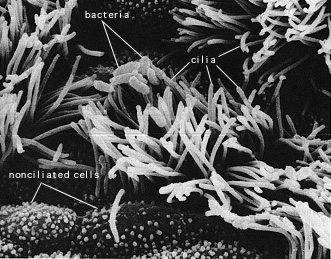
Whooping cough (pertussis) is a highly contagious disease that is caused by Bordetella pertussis. It is a disease of the respiratory tract and can be found in the mouth, nose, and throat of an infected person. There are about 5,000 cases each year in the USA. Even though it is possible to get pertussis at any age, 75% of the infected are under five years old, and 50% of these are children under one year old. The disease is most serious in infants and preschool-aged children.

Becoming Infected
We can become infected with whooping cough by breathing droplets
that are infected with the bacteria. These droplets are created when a
person who is infected coughs, sneezes, or even talks.
Symptoms
The sickness usually begins with flu-like symptoms that include
sneezing, a runny nose, low fever, and a mild cough. During the next two
weeks, the cough becomes more severe and is characterized by fits of violent
coughing. The fits can be long and severe enough that the infected person
may have trouble getting a breath of air. When this happens, the person
makes "whooping" noises after coughing. Babies that are under six months
old and adults usually do not make the "whooping" sound. A thick, clear
mucus may be "discharged". Partially immunized children and older people
have milder symptoms. The symptoms usually start five to ten days after
being exposed to someone with whooping cough, but they may start as many
as twenty-one days later. A person with pertussis is contagious from the
start of the earliest symptoms to three weeks after the start of the coughing
fits.
Vaccine
The vaccine is usually given together with diphtheria and tetanus
in a shot called DTP (diphtheria, tetanus, and pertussis). DTP should be
given at two, four, six, and fifteen months of age, and between four and
six years of age.
Bibliography
http://mano.icsd.hawaii.gov/doh/recource/comm_dis/cddpertu.htm
http://www.netmedicine.com/pt/PTINFO/pert.htm
http://medic.med.uth.tmc.edu/path/00001492.htm
Return to Bacterial Disease Page